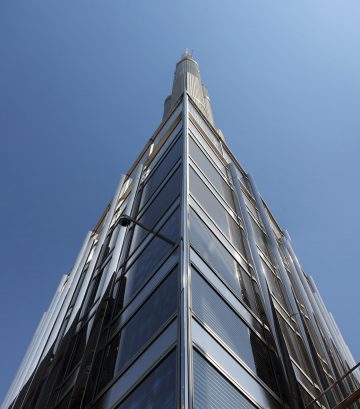What is it like living among the clouds? More and more people are choosing to make their homes high in the sky, with residential space in super- and mega-tall skyscrapers becoming increasingly common.
Not so long ago it was only commercial office buildings that broke the 200m mark. In 2000 there were 215 office buildings across the world that rose to over 200m, but only three residential buildings reached that height. As of last year, there were 255 residential buildings over 200m with an additional 184 being constructed.
Part of this huge increase in sky-high living space is down to trends for more mixed-use developments, encompassing offices, hotels, retail and apartments. The Burj Khalifa, for instance, is a mixed-use tower which remains the world’s tallest building at 828m and includes 900 private apartments which reach as high as the 108th floor.
Another factor that has made living in super- and mega-tall buildings more practical and attractive is the recent advances in building technology. Lifts with lightweight carbon fibre ropes are now capable of travelling at speeds of over 60kph and climbing for hundreds of metres. Innovative construction techniques such as dampening systems at the higher levels of skyscrapers also make it possible to build slender ‘skinny scrapers’ with a small footprint in crowded urban areas without them being prone to swaying in high winds or storms.
Making a home high over the city isn’t to everybody’s taste, but there are clear benefits for residents who are seeking endless, panoramic views. One resident of Eureka Tower in Melbourne says that, beyond the stunning and inspiring visual beauty of the views from their 74th floor apartment, they also no longer need to follow traffic or weather reports. Instead, they simply look out of their windows to see at a glance which roads are clear of traffic and when the clouds are rolling in from the horizon.
Clearly, effective building maintenance systems are a vital part of what makes these sky-high homes a liveable and attractive prospect, not least in terms of preserving the panoramic views that residents value so much. CoxGomyl have been called upon again and again to deliver complete end-to-end access solutions for some of the tallest buildings in the world. The innovative design of The Burj Khalifa required an equally innovative approach to the design and manufacture of building maintenance units, with 18 bespoke machines providing full facade access. The solution utilises nine wall mounted BMUs, three telescopic BMUs and a series of six smaller machines.
With increasing land values and rising populations in urban areas, the trend for high-rise residential buildings seems set to continue and grow, with CoxGomyl’s designers and engineers proving they are up to the challenges of delivering access solutions to effectively maintain the highest homes in the world.
Back to News
